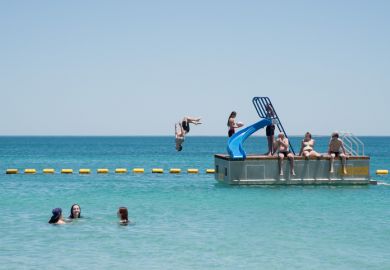Australia’s government will restrain overseas higher education student numbers at pre-pandemic levels, with the vocational education and training (VET) sector likely to incur much of the impact when the new international enrolment caps come in next year.
Canberra has announced that publicly funded universities will be allowed to admit around 145,000 new foreign students to their Australian campuses in 2025, subject to the successful passage of legislation. This compares with about 146,500 onshore overseas commencements in 2019.
However, postgraduate research students are exempted from the quota, along with Pacific Islanders, East Timorese, participants in Australian transnational education or “twinning” arrangements, and students with scholarships from the Australian or “key partner foreign” governments.
In a statement, the government said the overall cap would be at “around 2023 levels”. It said the reforms would strengthen the integrity of international education and “ensure it maintains its social licence”, while benefiting institutions that had been “disproportionately affected by the pandemic and uneven patterns of student returns”.
Institutional-level caps have been communicated to government-funded universities but not released publicly. Calculation of the limits factored in “data provided by universities”, including the numbers of new international students and their share of overall enrolments, the government said.
It has also confirmed that if the legislation passes parliament, “ministerial direction 107” – which prioritised some student visa applications over others, severely disadvantaging many institutions – will be replaced. A spokesman for education minister Jason Clare said a new ministerial direction would be issued “but it will not be the same”.
Melinda Hildebrandt, a higher education expert at Victoria University’s Mitchell Institute, said the revelations were “much softer” than many in the sector had feared. “It seems…more like a redistribution of international student revenue than a cap,” she said.
Dr Hildebrandt said the proposals resembled an international education levy “by stealth”, but it was difficult to evaluate their impacts without knowing the institutional caps.
The Innovative Research Universities welcomed the replacement of ministerial direction 107 and the removal of “priority groups of students” from the overall caps.
Executive director Paul Harris said the group wanted further changes to the legislation, particularly clauses capping international student numbers in individual courses. “But we welcome Minister Clare’s willingness to consider further amendments,” he said.
Universities Australia (UA) said the imposition of the overall cap would “apply a handbrake” to a major export industry. “We acknowledge the government’s right to control migration numbers, but this should not be done at the expense of any one sector – particularly one as economically important as education,” said UA chair David Lloyd.
“Even without legislated powers to limit international student numbers, the government has already taken a sledgehammer to the international education sector.”
Private universities and non-university higher education providers will be allocated another 30,000 places for fresh international enrolments in 2025, compared with about 39,400 in 2019.
A further 95,000 places will go to VET institutions. School students and people undertaking stand-alone English language courses are exempted from these limits.
The Independent Tertiary Education Council Australia said its members needed more detail about the reforms. In particular, they needed to know their institutional caps and the precise meaning of “new international student commencements”.
“Right now, when contemplating the future of their institution and the jobs of their staff, all our members have is a government media release,” said chief executive Troy Williams.
Register to continue
Why register?
- Registration is free and only takes a moment
- Once registered, you can read 3 articles a month
- Sign up for our newsletter
Subscribe
Or subscribe for unlimited access to:
- Unlimited access to news, views, insights & reviews
- Digital editions
- Digital access to THE’s university and college rankings analysis
Already registered or a current subscriber?








